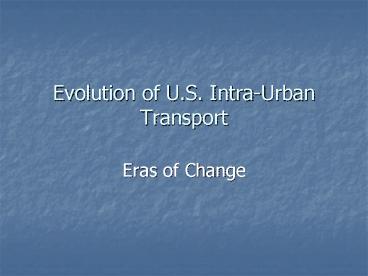Evolution of U'S' IntraUrban Transport - PowerPoint PPT Presentation
Title:
Evolution of U'S' IntraUrban Transport
Description:
Four Eras of Intra-Metro Growth and Transport Development. I ... 2. Most dramatic impact was swift development of urban fringes-radial trolley corridors ... – PowerPoint PPT presentation
Number of Views:63
Avg rating:3.0/5.0
Title: Evolution of U'S' IntraUrban Transport
1
Evolution of U.S. Intra-Urban Transport
- Eras of Change
2
Four Eras of Intra-Metro Growth and Transport
Development
- I Walking-Horsecar Era (1800-1890)
- II Electric Street Car Era (1890-1920)
- III Recreational Auto Era (1920-1945)
- IV Freeway Era (1945-present)
3
(No Transcript)
4
I Walking-Horse Car Era (1800-1890)
- 1. Highly agglomerated urban form
- 2. Travel largely on foot
- 3. People and activities required to cluster in
close proximity - 4. Arrival of railways in 1830s provided
opportunity for daily travel to and from
trackside commuting is born - 5. 1850s-light street rail drawn by horses
emerges - 6. Narrow band of land at citys edge opens and
horse car suburbs appear
5
II Electric Street Car Era (1890-1920)
- 1. Invention of electric traction motor
stimulated growth of electric trolleys - 2. Most dramatic impact was swift development of
urban fringes-radial trolley corridors - 3. Quality of housing and prosperity of streetcar
suburbs increased with distance from the central
city line - 4. Ubiquity of low fare trolley now provided all
residents access to intra-city mass transit is
born - 5. Specialized land use districts emerge- CBD
goes up with invention of elevator! - 6. Widest impact on social geography-congregation
of ethnic groups in neighborhoods - 7. Faster electric commuter trains superceded
steam locomotives in wealthiest suburbs
6
III Recreational Auto Era (1920-1945)
- 1. Electric trolleys, trains and subways begins
to transform many cities into metropoli - 2. Suburbs and mill-town intercity corridors
become spatially integrated - 3. Second urban transport revolution- auto enters
the scene with total freedom to travel - 4.1916- gt 2mil 1920 gt 8 mil 1930s gt 28 mil
- 5. Main impact- weekend outings auto dependency
commences!
7
(No Transcript)
8
III Recreational Auto Era (1920-1945)continued
- 6. Suburban home building industry no longer
subsidizes private street cars - 7. Modern urban transit crisis begins
- 8. During Depression local governments forced to
intervene with subsidies from public funds - 9. Expansion of residential development of auto
suburbia continues as large packages of cheap
land are gobbled up and transformed into suburbs,
e.g. Levittown (Philadelphia)
9
IV Freeway Era (1945 to Present )
- 1. Coming of age of the auto culture
- 2. 1956 Interstate Highway Act-massive
acceleration of deconcentration process - 3. Economic activities discovered
footlooseness- no longer tied to central
cities-emergence of beltway corridors - 4. Structural changes occur in urban form
- 5. Outlying metro coresedge cities become
suburban downtowns - 6. By 1993, 189 of these new urban
agglomerations, e.g. King of Prussia, Tysons
Corners , South Coast Metro, Schaumburg, Bellevue
10
(No Transcript)
11
(No Transcript)
12
Urban Transport in Post Industrial Metropolis
- Quaternary (info related) and quinary (management
and decision-making based) activities will
dominate U.S. employment - With intra-urban location costs fairly well
equalized across nation non-economic forces now
shape distribution of high technology - Silicon Valley, CA-major university, large pool
of skilled and semi-skilled labor, 300 days of
sunshine, recreational water, high quality
business environment
13
Urban Transport Challenges of 2010 Decade
- Efficiencies of moving people about the
dispersed, polycentric city - Few new freeways-why?
- 1. - too expensive
- 2. Environmental regulations
- 3. Disruption of existing neighborhoods and land
use activities - 4. Evidence that such freeways do not improve
traffic flow
14
Urban Transport Challenges of the 2010 Decade
- New public mass transit systems are being pursued
- Since 1960s heavy rail San Francisco, Atlanta,
Washington DC, Miami, Baltimore - Light rail systems Portland, Dallas, San Diego,
Buffalo, Louisville - But ridership levels have declinedcannot serve
low density suburbs
15
Transport Problems and New City Forms
- Too many new transit systems fail to recognize
that traditional CBD focused, hub and spoke
network has become irrelevant - Raid proliferation of suburban downtown- edge
cities- magnifies two problems - 1. Local level infrastructure usually lags well
behind growth in mushrooming coresgt congestion
results - 2. Reshaping of the metro space-economy produces
growing geographical mismatch between job
opportunities and housing - Edge cities surrounded by upper income
residential areasso most people who work in edge
cities must commute considerable distances from
affordable housing

